Apache Stronghold
Arizona, USA
People often consider the phrases ‘desert golf’ and ‘natural golf’ to be mutually exclusive. Mention the former and they will think of PGA West with its 20-foot deep bunkers and island green. Mention the latter and they their minds flash to Sand Hills, where only the barest amount of land was disturbed.
Apache Stronghold, in San Carlos, Arizona, represents a marriage of these two themes. This latest creation by Tom Doak’s Renaissance Golf Design firm is located on the reservation of the San Carlos Apache Tribe and must be classified as desert golf, replete with cacti, mesquite trees, rocks and rattlesnakes. But it also provides a fresh example of minimalism as an unusually small amount of ground was moved to build the course. Unlike so many other desert layouts, Apache Stronghold does not look as if it were imposed on the property. Similar to Sand Hills, it gives the impression that the main task was just to grow the grass.
Somewhat like Bill Coore and Ben Crenshaw at Sand Hills, Doak and his team had a vast property on which to lay out the course. Such situations provide an architect the best opportunity to showcase his skill. If given a small piece of land, there are but so many variations of the routing from which to choose. A sprawling site, however, offers an almost endless number of permutations, requiring both imagination and discipline on the part of the architect.
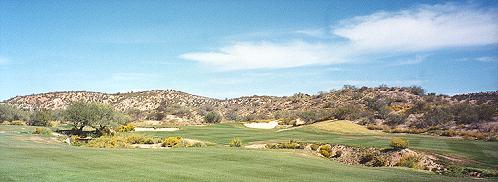
At Apache Stronghold one design firm that interviewed for the job suggested stringing out several holes along the highway in hopes of attracting ‘walk-in’ customers. That idea never crossed Doak’s mind as he went in search of the best features of the property, found at the part of the course the farthest from the highway (holes 2-7 on Doak’s design). As this example illustrates, Apache Stronghold is emphatically not just a case of ‘Well, given such a nice piece of land, anyone could have designed a course of the same high quality.’ If that other architect had been awarded the job, the world might never hear of Apache Stronghold.
After Renaissance had taken pains with the routing, the course merely follows the wonderful site with not surprisingly the best parts of the property offering the best holes. Holes 1 – 7, which rival 1 – 7 at Lost Dunes, 10 – 15 at High Pointe and 10 – 15 at Riverfront for Renaissance’s best stretch of holes, were laid out over the most interesting terrain, working their way through the rocky valleys and over and around washes. Holes 13 – 15 are another inspired stretch.
Apache Stronghold offers further proof that minimalism does not produce dull courses – far from it. The courses just reflect the land – on more interesting land, such as here and at High Pointe, the golf will be dramatic, heroic and perhaps even ‘quirky’ in spots. Apache Stronghold is the first course that really struck the authors with the idea of applying minimalism to green complexes. The first green, for example, is bisected by a swale that splits the green into its higher sides. Originally Doak was going to build the green short and to the left of the current site, but the temptation to use this neat, natural feature was too much. The fifth green offers another example – the wild contours were already there, as can be verified by looking at the undulations coming from the hillside on the left.
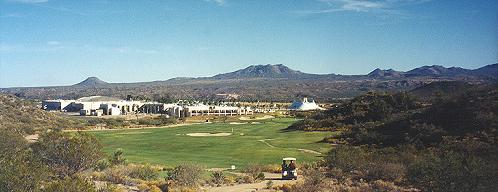
The downhill 18th makes for a fittingly heroic conclusion.
Apache Stronghold also deserves praise for the ease with which it can be walked. True, it is not as walker-friendly as the two courses at Talking Stick, but those courses are dead-flat whereas Apache Stronghold is anything but. There are hefty hikes to the 14th and 18th tees, but the authors can see no way to have avoided that (it would have been a crime not to build the 14th).
Holes to Note:
Forth hole, 400 yards; The authors’ favorite hole, the fourth offers a fresh perspective from the tee: the farther you drive the ball, the more room you have. The bunker at the inside corner of this dog-leg left requires 235 yards to carry, but such a feat is most reasonable at this altitude. The approach is even more appealing, with its modest, sloping green nestled between two large hills and, for most approaches, the sky is the only backdrop. The effect is superb.
Fifth hole, 465 yards; Unlike the fourth, the fifth is straightaway and again allows plenty of room once a bunker some 200 yards out on the left has been cleared. The approach is to the most severe and controversial green on the course, with its front shelf some 15 yards deep before dropping off to the remaining rolling 25 yards of putting surface. The most difficult two-shotter on the course, and by a good margin.
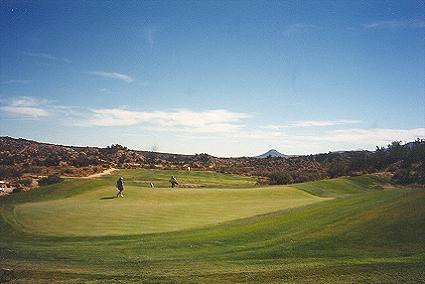
From behind the 5th green.
Sixth hole, 310 yards; A fine ‘half-par’ hole and Doak’s first reachable two-shotter. Even though the authors wonder if this hole has become slightly overrated relative to the merits of other holes on the course, it is notable because it is a drivable two-shotter that, well, is drivable. This element adds much more excitement than other short two-shotters (e.g., the 15th at World Woods (Pine Barrens)) where your Sunday best still leaves a 20-40 yard pitch. The prospect of an eagle putt offers more temptation than a pitch or chip. Also, this hole occupies the authors’ favorite part of the property, one that offers no hint whatsoever of anything else in the world.
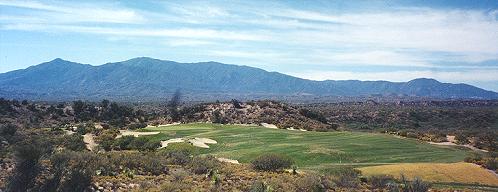
The tempting prospect from the 6th tee.
Seventh hole, 435 yards;The downhill tee shot is both thrilling and strategic as the player wants to hug the wash running the right side as the hole continues to bend that way. The approach is a sheer delight, as the player emerges from what feels like a canyon to have the entire panorama unfold before him. The shot, however, is a real sleeper as the ball continues to run from the front-right of the green to the back-left. The grand scale of the backdrop of the mountains makes the approach look flatter than it actually is.
Thirteenth hole, 450 yards; A sharp dog-leg right that does so well what few other similar-shaped holes do. Similar in concept to the 6th at Royal Melbourne (West) (but with a markedly different appearance) the player is expected to drive over the bunkers at the corner. Most importantly, though, is that the hole was designed for this play as there is ample fairway over the bunkers to contain such a drive. One of the authors’ pet peeves is the dog-leg hole whose fairway narrows to such a degree just past the corner that a tee shot that carries the trouble at the corner has little chance of remaining in the fairway (e.g., the 15th at Bay Hill). The approach to the 13th is first class, through a valley to a sloping green. Standing in the 13th fairway, the player will be forgiven if he momentarily forgets where he is and expects to find the Irish Sea over the ridge behind the green.
Fourteenth hole, 185 yards; The 14th is set on the most dramatic piece of the property as it runs along the top of a ridge. Doak put the site to good use, building a very good Redan. With a bit more right-to-left and front-to-back slope, the hole could be the second-best Redan in the country. (It should be noted also what an effective foil the 15th green with its left-to-right diagonal and sunken rear portion to this one.)
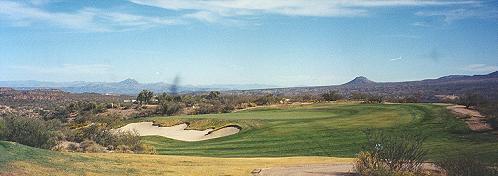
Doak’s Redan
One fascinating aspect of Apache Stronghold is its incorporation of favorite design elements: the Redan (the 14th), the Principal’s Nose (the 18th), alternate fairways/routes from the tee (the 2nd and 10th) and a bunker in the middle of the fairway at just the right distance short of the green on a three-shotter (the 16th). This use of traditional strategic design in a non-traditional setting (the desert) is refreshing.
A further distinction between Apache Stronghold and other desert courses is Apache’s modest amount of formal bunkering. There are approximately 45 bunkers on the course, and they hardly dominate play. After 45 holes there, one author played only three bunker shots. However, the player is not struck by this fact as, being in the desert, he is surrounded by sand. Bunkers are by necessity artificial creations, yet again there are few man-made impositions on the course.
One minor quibble with Apache Stronghold is that the player feels he is asked to play the same shot on several occasions (e.g., a high fade from the tee on holes 7,13 and 15). Still, the authors consider Apache Stronghold to be Renaissance Golf Design’s most satisfying project since High Pointe and only hope that indifferent conditioning will not mask this terrific design too.
Renaissance was able to start fresh (unlike Stonewall), without difficult routing obstacles (Lost Dunes) and without housing concerns (Riverfront). They were given a terrific site and made the most of it, the highest compliment we know.
Apache Stronghold
Arizona, USA
Fifth hole, 465 yards; Unlike the fourth, the fifth is straightaway and again allows plenty of room once a bunker some 200 yards out on the left has been cleared. The approach is to the most severe and controversial green on the course, with its front shelf some 15 yards deep before dropping off to the remaining rolling 25 yards of putting surface. The most difficult two-shotter on the course, and by a good margin.

From behind the 5th green.
Sixth hole, 310 yards; A fine ‘half-par’ hole and Doak’s first reachable two-shotter. Even though the authors wonder if this hole has become slightly overrated relative to the merits of other holes on the course, it is notable because it is a drivable two-shotter that, well, is drivable. This element adds much more excitement than other short two-shotters (e.g., the 15th at World Woods (Pine Barrens)) where your Sunday best still leaves a 20-40 yard pitch. The prospect of an eagle putt offers more temptation than a pitch or chip. Also, this hole occupies the authors’ favorite part of the property, one that offers no hint whatsoever of anything else in the world.

The tempting prospect from the 6th tee.
Seventh hole, 435 yards;The downhill tee shot is both thrilling and strategic as the player wants to hug the wash running the right side as the hole continues to bend that way. The approach is a sheer delight, as the player emerges from what feels like a canyon to have the entire panorama unfold before him. The shot, however, is a real sleeper as the ball continues to run from the front-right of the green to the back-left. The grand scale of the backdrop of the mountains makes the approach look flatter than it actually is.
Thirteenth hole, 450 yards; A sharp dog-leg right that does so well what few other similar-shaped holes do. Similar in concept to the 6th at Royal Melbourne (West) (but with a markedly different appearance) the player is expected to drive over the bunkers at the corner. Most importantly, though, is that the hole was designed for this play as there is ample fairway over the bunkers to contain such a drive. One of the authors’ pet peeves is the dog-leg hole whose fairway narrows to such a degree just past the corner that a tee shot that carries the trouble at the corner has little chance of remaining in the fairway (e.g., the 15th at Bay Hill). The approach to the 13th is first class, through a valley to a sloping green. Standing in the 13th fairway, the player will be forgiven if he momentarily forgets where he is and expects to find the Irish Sea over the ridge behind the green.
Fourteenth hole, 185 yards; The 14th is set on the most dramatic piece of the property as it runs along the top of a ridge. Doak put the site to good use, building a very good Redan. With a bit more right-to-left and front-to-back slope, the hole could be the second-best Redan in the country. (It should be noted also what an effective foil the 15th green with its left-to-right diagonal and sunken rear portion to this one.)

Doak’s Redan
One fascinating aspect of Apache Stronghold is its incorporation of favorite design elements: the Redan (the 14th), the Principal’s Nose (the 18th), alternate fairways/routes from the tee (the 2nd and 10th) and a bunker in the middle of the fairway at just the right distance short of the green on a three-shotter (the 16th). This use of traditional strategic design in a non-traditional setting (the desert) is refreshing.
A further distinction between Apache Stronghold and other desert courses is Apache’s modest amount of formal bunkering. There are approximately 45 bunkers on the course, and they hardly dominate play. After 45 holes there, one author played only three bunker shots. However, the player is not struck by this fact as, being in the desert, he is surrounded by sand. Bunkers are by necessity artificial creations, yet again there are few man-made impositions on the course.
One minor quibble with Apache Stronghold is that the player feels he is asked to play the same shot on several occasions (e.g., a high fade from the tee on holes 7,13 and 15). Still, the authors consider Apache Stronghold to be Renaissance Golf Design’s most satisfying project since High Pointe and only hope that indifferent conditioning will not mask this terrific design too.
Renaissance was able to start fresh (unlike Stonewall), without difficult routing obstacles (Lost Dunes) and without housing concerns (Riverfront). They were given a terrific site and made the most of it, the highest compliment we know.
The End





![The Park, West Palm (Lit 9) [2023]](https://golfclubatlas.com/wp-content/uploads/2024/12/IMG_7092-2-scaled-500x383.jpg)


